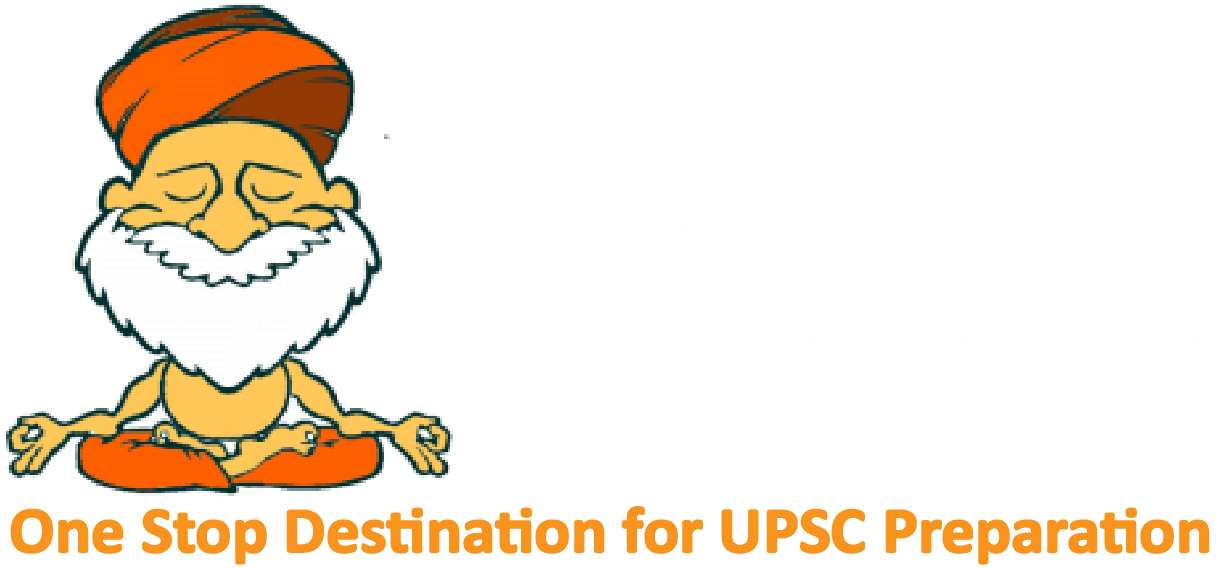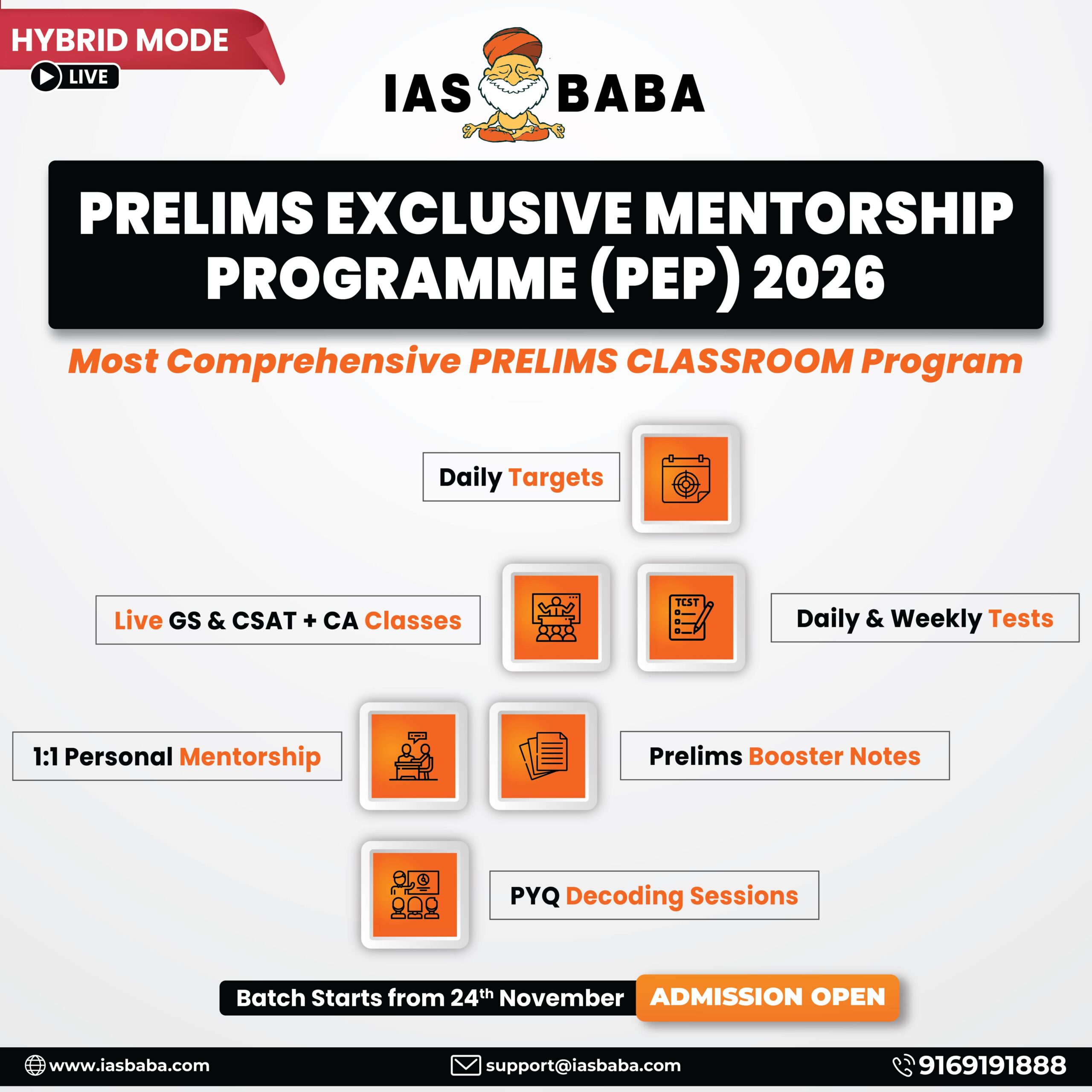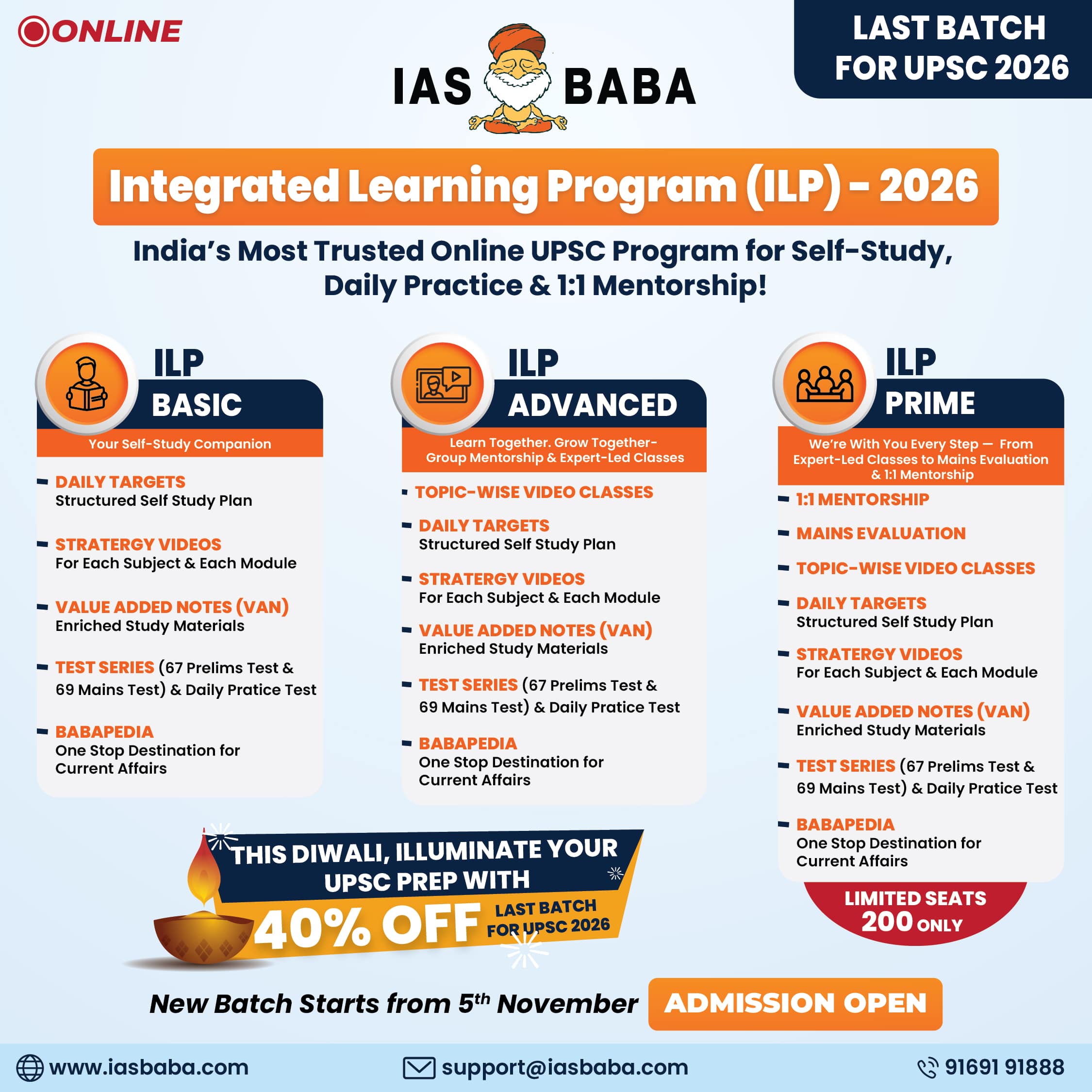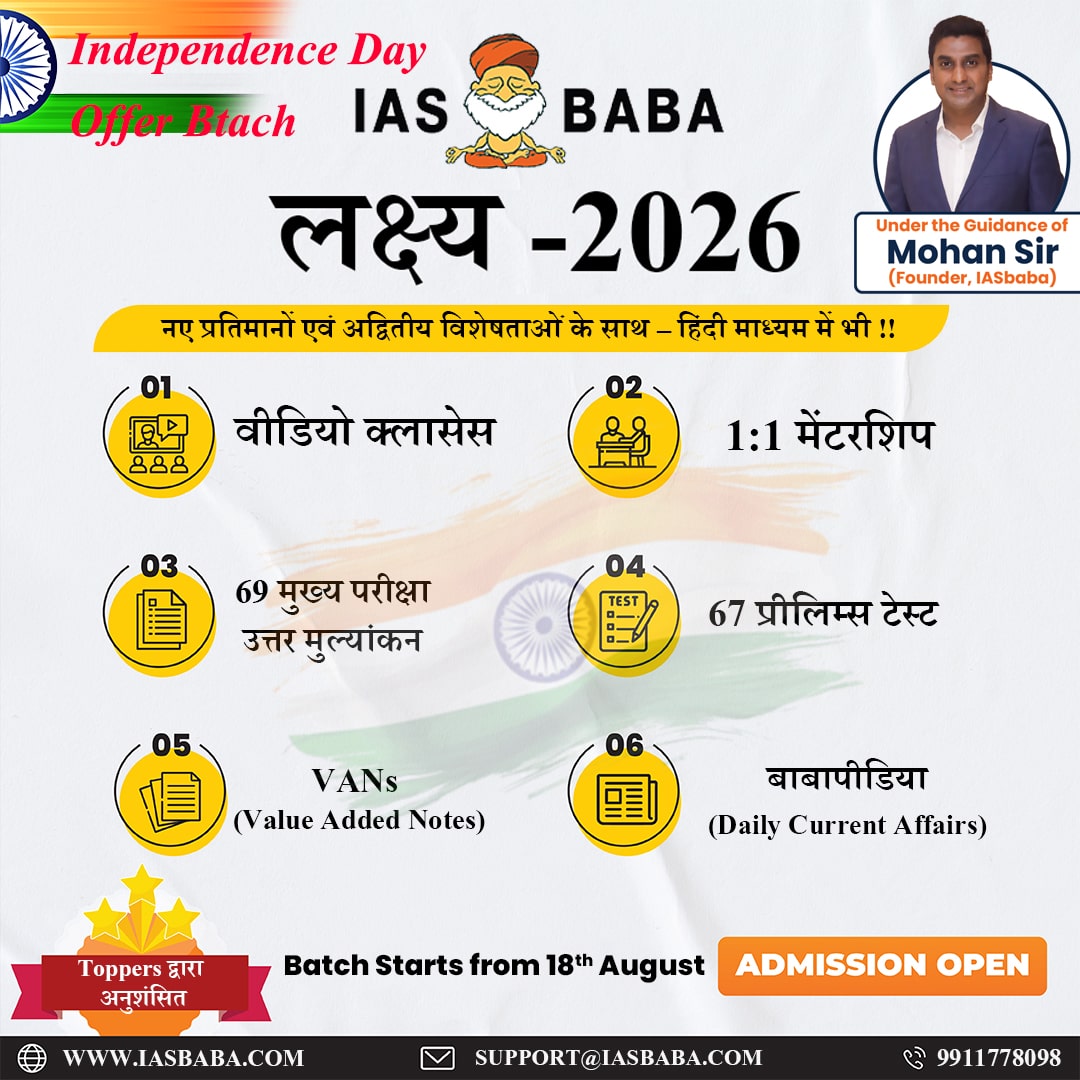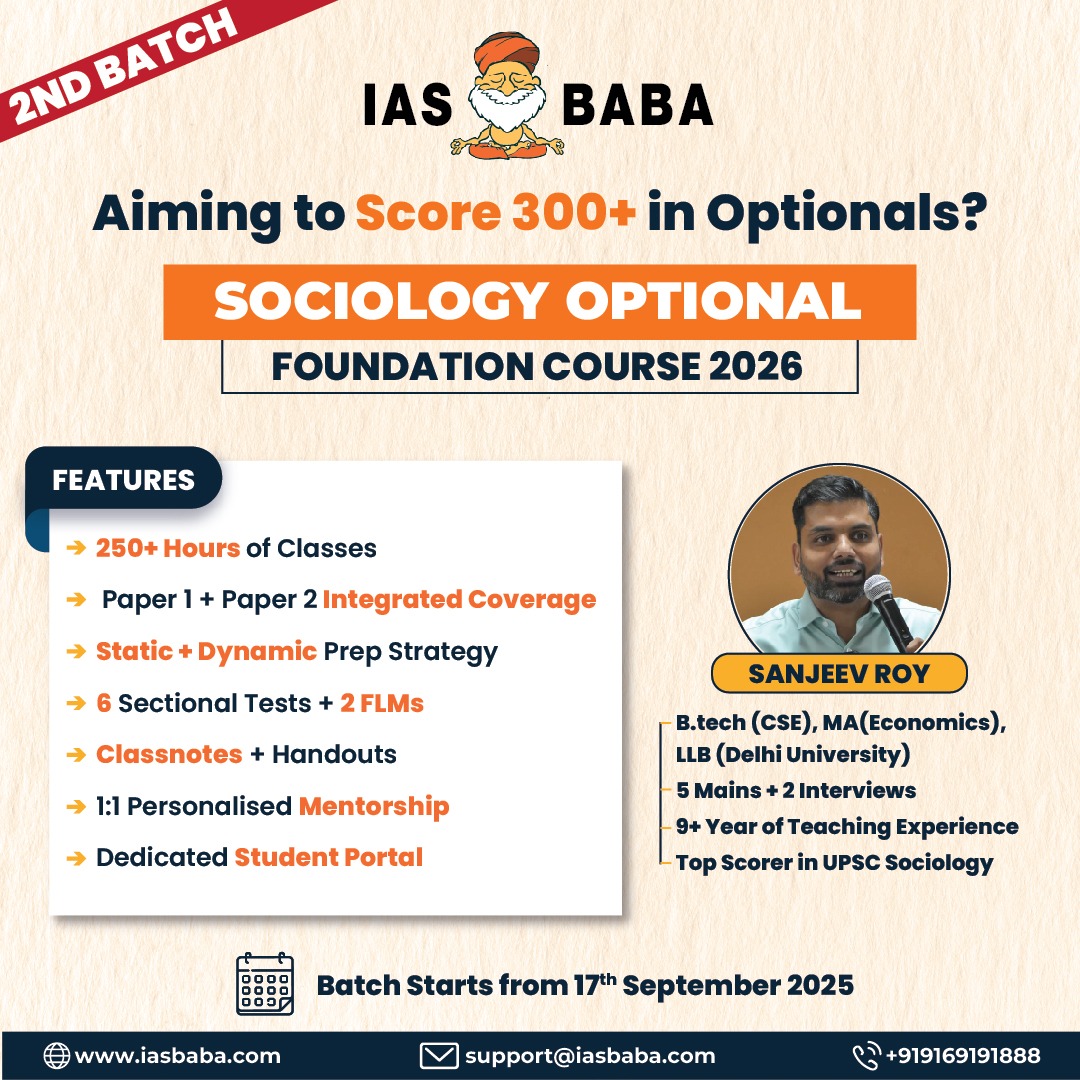IASbaba Daily Prelims Quiz
For Previous Daily Quiz (ARCHIVES) – CLICK HERE
The Current Affairs questions are based on sources like ‘The Hindu’, ‘Indian Express’ and ‘PIB’, which are very important sources for UPSC Prelims Exam. The questions are focused on both the concepts and facts. The topics covered here are generally different from what is being covered under ‘Daily Current Affairs/Daily News Analysis (DNA) and Daily Static Quiz’ to avoid duplication. The questions would be published from Monday to Saturday before 2 PM. One should not spend more than 10 minutes on this initiative.
Gear up and Make the Best Use of this initiative.
Do remember that, “the difference between Ordinary and EXTRA-Ordinary is PRACTICE!!”
Important Note:
- Don’t forget to post your marks in the comment section. Also, let us know if you enjoyed today’s test 🙂
- After completing the 5 questions, click on ‘View Questions’ to check your score, time taken, and solutions.
Test-summary
0 of 5 questions completed
Questions:
- 1
- 2
- 3
- 4
- 5
Information
To view Solutions, follow these instructions:
- Click on – ‘Start Test’ button
- Solve Questions
- Click on ‘Test Summary’ button
- Click on ‘Finish Test’ button
- Now click on ‘View Questions’ button – here you will see solutions and links.
You have already completed the test before. Hence you can not start it again.
Test is loading...
You must sign in or sign up to start the test.
You have to finish following test, to start this test:
Results
0 of 5 questions answered correctly
Your time:
Time has elapsed
You have scored 0 points out of 0 points, (0)
| Average score |
|
| Your score |
|
Categories
- Not categorized 0%
| Pos. | Name | Entered on | Points | Result |
|---|---|---|---|---|
| Table is loading | ||||
| No data available | ||||
- 1
- 2
- 3
- 4
- 5
- Answered
- Review
-
Question 1 of 5
1. Question
-
Consider the following statements regarding Khangchendzonga National Park:
-
It is the only mixed World Heritage Site in India, recognized for both natural and cultural significance.
-
It is located entirely within the state of Sikkim.
-
The park is home to the third-highest peak in the world, Mount K2.
How many of the above statements is/are correct?
Correct
-
Solution (b)
Explanation:
- Khangchendzonga National Park was inscribed as India’s first “Mixed World Heritage Site” by UNESCO in 2016 for its cultural and natural values. Hence Statement 1 is Correct
- The park lies entirely within the Indian state of Sikkim. Hence Statement 2 is Correct
The park contains Mount Kanchenjunga, the world’s third-highest peak, not Mount K2 (which is in the Karakoram range). Hence Statement 3 is Incorrect
Incorrect
-
Solution (b)
Explanation:
- Khangchendzonga National Park was inscribed as India’s first “Mixed World Heritage Site” by UNESCO in 2016 for its cultural and natural values. Hence Statement 1 is Correct
- The park lies entirely within the Indian state of Sikkim. Hence Statement 2 is Correct
The park contains Mount Kanchenjunga, the world’s third-highest peak, not Mount K2 (which is in the Karakoram range). Hence Statement 3 is Incorrect
-
-
Question 2 of 5
2. Question
-
Consider the following statements regarding the UN Water Convention:
-
The Convention entered into force in 2013 after the amendment allowing accession by all UN member states was adopted.
-
India and China are parties to the Convention.
Which of the statements is/are correct?
Correct
-
Solution (d)
Explanation:
- The UN Water Convention was adopted in 1992 and entered into force in 1996. The amendment to allow accession by all UN member states was adopted in 2003, but it entered into force only in 2013. Thus, the Convention itself entered into force in 1996, not 2013. Hence Statement 1 is Incorrect
As of now, neither India nor China has become a party to the Convention, although several non-European countries such as Chad and Senegal have joined. Hence Statement 2 is Incorrect
Incorrect
-
Solution (d)
Explanation:
- The UN Water Convention was adopted in 1992 and entered into force in 1996. The amendment to allow accession by all UN member states was adopted in 2003, but it entered into force only in 2013. Thus, the Convention itself entered into force in 1996, not 2013. Hence Statement 1 is Incorrect
As of now, neither India nor China has become a party to the Convention, although several non-European countries such as Chad and Senegal have joined. Hence Statement 2 is Incorrect
-
-
Question 3 of 5
3. Question
-
The Koraga tribe, classified as a Particularly Vulnerable Tribal Group (PVTG), is primarily found in which Indian state?
Correct
-
Solution (c)
Explanation:
The Koraga tribe is one of the Particularly Vulnerable Tribal Groups (PVTGs) of India, primarily inhabiting the coastal districts of Karnataka, such as Udupi, Dakshina Kannada, and Uttara Kannada. Smaller populations are also found in northern Kerala.
They are among the earliest known forest-dwelling communities of the Western Ghats region and traditionally engaged in basket-making and manual labor. The tribe faces issues such as social exclusion and poor socio-economic conditions, leading to their classification as a PVTG by the Government of India.
The Ministry of Tribal Affairs recognizes the Koragas under the Scheduled Tribes list of Karnataka, and several welfare schemes are being implemented to improve their education, livelihood, and housing conditions.
Incorrect
-
Solution (c)
Explanation:
The Koraga tribe is one of the Particularly Vulnerable Tribal Groups (PVTGs) of India, primarily inhabiting the coastal districts of Karnataka, such as Udupi, Dakshina Kannada, and Uttara Kannada. Smaller populations are also found in northern Kerala.
They are among the earliest known forest-dwelling communities of the Western Ghats region and traditionally engaged in basket-making and manual labor. The tribe faces issues such as social exclusion and poor socio-economic conditions, leading to their classification as a PVTG by the Government of India.
The Ministry of Tribal Affairs recognizes the Koragas under the Scheduled Tribes list of Karnataka, and several welfare schemes are being implemented to improve their education, livelihood, and housing conditions.
-
-
Question 4 of 5
4. Question
-
Consider the following statements regarding the National Technical Textiles Mission:
-
The Mission was launched by the Ministry of Textiles to promote research, innovation, and domestic manufacturing in technical textiles.
-
One of its components focuses on the use of technical textiles in agriculture, water resources, and health care sectors.
-
The Mission is designed to be implemented over a period of ten years from 2020 to 2030.
Which of the statements is/are correct?
Correct
-
Solution (b)
Explanation:
- The National Technical Textiles Mission was launched by the Ministry of Textiles in 2020 to boost innovation, research, and domestic production of technical textiles in India. Hence Statement 1 is Correct
- The Mission includes components such as the application of technical textiles in agriculture (AgroTech), water resources, health care, and infrastructure sectors. Hence Statement 2 is Correct
- The Mission was approved for implementation over a four-year period (2020–2024), not ten years. Hence Statement 3 is Incorrect
Incorrect
-
Solution (b)
Explanation:
- The National Technical Textiles Mission was launched by the Ministry of Textiles in 2020 to boost innovation, research, and domestic production of technical textiles in India. Hence Statement 1 is Correct
- The Mission includes components such as the application of technical textiles in agriculture (AgroTech), water resources, health care, and infrastructure sectors. Hence Statement 2 is Correct
- The Mission was approved for implementation over a four-year period (2020–2024), not ten years. Hence Statement 3 is Incorrect
-
-
Question 5 of 5
5. Question
Which of the following best describes Soil Organic Carbon (SOC)?
Correct
-
Solution (a)
Explanation:
Soil Organic Carbon refers to the carbon stored in organic matter such as decomposed plants, roots, and microorganisms, playing a key role in soil fertility and climate regulation.
Incorrect
-
Solution (a)
Explanation:
Soil Organic Carbon refers to the carbon stored in organic matter such as decomposed plants, roots, and microorganisms, playing a key role in soil fertility and climate regulation.
- Current Affairs Quiz, IAS Daily Current Affairs Quiz, IAS UPSC Current Affairs Quiz, IAS UPSC Prelims Quiz, IASbaba's Current Affairs Prelims Quiz, IASbaba's Daily Quiz, IASbaba's UPSC Quiz, Prelims Current Affairs Quiz, UPSC Current Affairs Quiz, UPSC Current Affairs Quiz IASbaba, UPSC Daily Current Affair Quiz, UPSC IAS Daily Quiz

